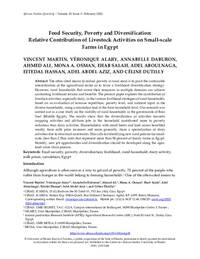Food Security, Poverty and Diversification: Relative Contribution of Livestock Activities on Small-scale Farms in Egypt

Authors:
The often-cited means to reduce poverty in rural areas is to push the sustainable
intensification of the agricultural sector or to favor a livelihood diversification strategy.
However, rural households that invest their resources in multiple domains can achieve
contrasting livelihood returns and benefits. The present paper explores the contribution of
livestock activities, especially dairy, in the various livelihood strategies of rural households,
based on an evaluation of revenue repartition, poverty level, and nutrient input in the
diverse households, using a simulation tool at the farm household level. Our research was
carried out in a case study on the viability of rural households in the governorate of Beni
Suef (Middle Egypt). The results show that the diversification of activities towards
cropping activities and off-farm jobs in the household contributed more to poverty
reduction than dairy activities. Householders with small herds and land access benefited
weakly from milk price increases and more generally, from a specialization of dairy
activities due to structural constraints. This calls for identifying new rural policies for smallscale (less than 2.5ha) units that represent more than 90 percent of family farms in Egypt.
Notably, new job opportunities and diversification should be developed along the agrofood value chain process.
